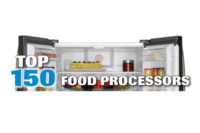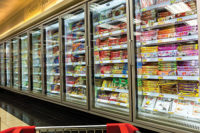Top 150 Frozen Food Processors: From Freezer to Microwave to Table
Refrigerated & Frozen Foods provides an overview of the Top 25 frozen food processors in each of the six sectors.

Stopping for a bite to eat is a thing of the past. For today’s consumers, it’s about eating on the run. That’s why frozen food processors are pressed to develop

|
tasty, yet healthy products that provide convenience, portability and portion control, all wrapped up in an easy-to-open, easy-to-thaw-and-serve package.
THE EVOLUTION OF FROZEN FOODS
In 1929, Clarence Birdseye, founder of Birdseye Seafood, Inc., which today, is the Birds Eye brand of Pinnacle Foods, Inc., invented the quick-frozen foods industry while on a fur-trapping expedition. He saw the natives using freezing methods to preserve foods, which later turned into fish-freezing experiments.
Today, freezing food has become a way of life. From frozen entrées to frozen fruits and vegetables to even frozen pastries, the act of freezing food enables consumers to keep more food for a longer period of time.
In honor of National Frozen Foods Month, this is Refrigerated & Frozen Foods’ Top 150 Frozen Foods Processors, which breaks down the Top 25 frozen food processors in each of the six sectors (see categories in the sidebar on the right). Processors are ranked by annual net sales.
Some frozen foods processors declined to provide annual sales or refused to update company information. This report represents Refrigerated & Frozen Foods’ best efforts to reflect pertinent sales from all channels. Sales figures and estimates, which are marked with an asterisk(*), are based on company reports, news releases, market analysts’ reports, industry media and more. Figures may include shelf-stable products, some refrigerated product lines and/or company-wide figures. All data and company information is as of Feb. 28.
ABOUT THE REPORT

|
This year’s Top 150 Frozen Foods Processors report garnered an overall 71% update rate across all six categories.
For example, the frozen meat, poultry and seafood sector experienced an 88% update rate, with 22 out of the 25 processors submitting updated company information.
Twenty out of 25 processors (80%) of frozen baked goods returned their forms for updating their company profile, while 18 out of 25 processors (72%) of frozen snacks, appetizers and side dishes updated their data.
Processors of frozen meals and entrées and frozen fruits and vegetables tied with 64% (16 out of 25 processors), while the frozen dairy sector wavered at 60% of the data being updated from the processor themselves.
A special thank you goes to Refrigerated & Frozen Foods’ sister publications—National Provisioner and Dairy Foods—for their research and support in the meat/poultry/seafood and dairy foods sections, respectively.
Not Just Your Average TV Dinner
It used to be that frozen meals meant TV dinners—you know, the ready-made meal with individualized portions of soggy vegetables, overcooked potatoes and turkey that tastes like the plastic it was microwaved in.
According to an October 2012 frozen foods report from Packaged Facts, Rockville, Md., consumers shifted away from frozen entrées in favor of fresher alternatives. The report says that “57% of U.S. adults cited a preference for fresh foods as a reason for not buying frozen foods in the past three months.”
“Frozen meals have a long-standing perception of being the TV dinner,” says Sarah Day LeVesque, a food and beverage analyst for Chicago-based Mintel. “The

|
perception [of a TV dinner] is still highly processed, not offering a full, balanced meal, or made with ingredients consumers don’t understand.”
Thankfully, TV dinners of the past have transformed into the gourmet entrées of today, sometimes complete with all-natural ingredients, whole grains, real fruits and vegetables and a “less processed” taste.
In fact, fewer meals are made from scratch (59% in 2011, down from 72% in 1984), according to NPD Group’s National Eating Trends. This means more and more shoppers are perusing the freezer aisles for those quick and easy meal solutions.
THE BREAKFAST BOOM
The breakfast entrées category experienced a 20% sales increase, from $10 billion in 2007 to $12 billion in 2011, and is forecasted to continue to grow nearly 26% from 2012-17, reaching a projected $15.7 billion, according to Chicago-based Mintel.
The majority of consumers (69%) who eat breakfast foods regularly during the week consider “low cholesterol” and “heart-healthy” claims important, the study says. Yet, 57% of respondents would be willing to spend more on higher-quality prepackaged breakfast foods. Nearly 41% would like to see more organic prepackaged breakfast products.
“Eating at home to save money and the convenience of many products in the breakfast category likely aided in its impressive sales growth,” says Carla Dobre-Chastain, food analyst at Mintel. “While price will continue to play an important role when it comes to breakfast foods, Mintel’s research shows that consumers are willing to pay more for higher-quality breakfast products.”
NOTEWORTHY EVENTS

|
January 2012— Request Foods opened a 230,000-square-foot plant adjacent to its Holland, Mich., headquarters that produces frozen skillet meals.
April 2012—Ajinomoto reorganized its U.S. units and moved its consumer food division to Portland, Ore., where Ajinomoto Frozen Foods is located.
June 2012—Dave Woodward was named president and CEO of Heinz North America, while Brendan Foley was named president, U.S. consumer products and John Hans named president, U.S. foodservice.
November 2012—High Liner Foods closed two plants and completed the integration of Icelandic USA.
ConAgra Foods acquired private label manufacturer Ralcorp Holdings. The transaction is expected to close by March 31.
December 2012—The Hillshire Brands Co. moved its headquarters from Downers Grove, Ill., to Chicago.
The Comeback Kings
At IPPE 2013 in Atlanta, manufacturers showcased the latest innovations in equipment, supplies and services for the meat and poultry industry. From chilling systems and tunnel freezers to spiral ovens and condensers, there was no shortage of advanced technology.
Now, processors are stepping it up a notch with their own version of “new and improved.” And, for an industry that has been through the ringer—think pink slime—it certainly is making a comeback.
For more on this category, check out the New Retail Products section, page 26.
For an outline of the Top 10 meat processors, go to page 40.
May 2012—Koch Foods’ subsidiary, JCG Foods, purchased Cagle’s in an auction after it filed for bankruptcy in October 2011.

|
July 2012—Cargill Meat Solutions purchased AFA Foods’ ground beef processing plant after it filed chapter 11 protection in April 2012.
December 2012—The Hillshire Brands Co. moved its headquarters from Downers Grove, Ill., to Chicago.
Butterball, LLC acquired Gusto Packing Co.
Wayne Farms purchased a poultry complex in Dothan, Ala.
January 2013—Marfrig Group named former Cargill executive Frank Ravndal, Jr. CEO of Keystone Foods.
February 2013—Golden State Foods acquired majority stake in Groenz Group Ltd.
JBS purchased XL Foods, including two beef packing plants and two feedlots.
Smithfield Foods signed a non-binding letter of intent to form 50/50 joint venture with Kansas City Sausage Co. and its sister company, Pine Ridge Farms.
Frozen Dairy Outshines Winter Weather
One thing is for certain—when it comes to eating ice cream, diving into a pint is no longer saved for those hot, summer days. Today, ice cream is consumed any day, every day, regardless of the weather elements.
Emerging from two years of struggling sales, the ice cream and frozen novelty market posted a 4.1% increase to reach $10.7 billion in retail sales in 2011 and was poised for an additional 4% growth in 2012, according to a study conducted by Chicago-based Mintel.

|
When buying ice cream or other frozen novelties, 94% of respondents say they base their decision on flavor, while 83% look at price and 72% look for a sale or promotion. When it comes to brand loyalty, slightly more than two-thirds (68%) of respondents make their selections based on brand alone. New flavor profiles, better-for-you ingredients and unique packaging concepts will also be instrumental in the success of the frozen dairy category.
Meanwhile, reduced fat (38%), reduced sugar (38%) and reduced calorie (36%) are the most important claims consumers are looking for on the packaging, the study says. Likewise, gluten-free and dairy-free products are rapidly growing in popularity with 14% and 15% of Mintel respondents saying they are “very” or “somewhat important” to them.
For an outline of the Top 10 ice cream producers, go to page 40.
NOTEWORTHY EVENTS
December 2012—Nate Schmid named president of Smith Dairy Co.
February 2013—Blue Bell Creameries is expanding its Brenham, Texas, headquarters plant to include a cold storage unit.
Smith Dairy also redesigned the cartons for its Ruggles Premium Ice Cream to now include flavor descriptions, eye-catching photos and QR codes.
A Snack Attack of Sorts
Usually when one hears the word “snack,” you think of chips and pretzels.
Not anymore.
Processors of frozen snacks, appetizers and side dishes are re-inventing the way consumers snack.
For an outline of the Top 10 producers of frozen side dishes, go to page 42.
NOTEWORTHY EVENTS
January 2012—J. R. Simplot began construction on its potato processing plant. Completion is expected for spring 2014.
June 2012—Dave Woodward was named president and CEO of Heinz North America, while Brendan Foley was named president, U.S. consumer products and John Hans named president, U.S. foodservice.
October 2012—Bylada Foods acquired Health is Wealth, a natural foods processor.
November 2012—ConAgra Foods acquired private label manufacturer Ralcorp Holdings. The transaction is expected to close by March 31.
December 2012— Rich Products Corp. acquired two food companies—Goglanian Bakeries Inc. and f’real foods LLC—and entered into a joint venture with Twin Star Bakery.
Maple Leaf Foods announced plans to sell its potato processing facility in Alberta, Canada, to Cavendish Farms.
March 2013— J. R. Simplot also plans to erect a new headquarters building in Boise, Idaho. Completion is projected for late 2015/early 2016.
Chef-Inspired, Consumer-Approved
From TLC’s Cake Boss to the Food Network’s Cupcake Wars, Americans are obsessed with baking. But, the nation’s appetite for scrumptious desserts doesn’t

|
stop with onscreen displays. That’s because the frozen baked goods category continues to rise to the occasion.
Case in point—the frozen bread/roll/pastry dough category raked in $96.3 million in sales, 13 week ending Dec. 30, 2012, up from $53.5 million in sales, 13 week ending Oct. 2, 2011, according to SymphonyIRI Group, a Chicago-based market research firm.
Meanwhile, the frozen cookie dough sector experienced $9.1 million in sales while frozen baked bread/rolls/biscuits saw $215.7 million, 13 week ending Dec. 30, 2012, up from $1.3 and $174.3 million, respectively, from 13 week ending Oct. 2, 2011.
Dawn Food Products, Jackson, Mich., in conjunction with TLC’s Cake Boss, developed Cake Boss brand 7-inch diameter decorated layered cakes. The ready-to-sell cakes and cupcakes will be available year-round in an array of designs and flavors.
For an outline of the Top 10 frozen bread and dough producers, go to page 42.
NOTEWORTHY EVENTS
November 2012—ConAgra Foods acquired private label manufacturer Ralcorp Holdings. The transaction is expected to close by March 31.
December 2012—Hillshire Brands moved its headquarters from Downers Grove, Ill., to Chicago.
Dianne’s Fine Desserts broke apart from H.J. Heinz Co. as a stand-alone operation, focusing exclusively on the frozen dessert category.
February 2013—Aunt Millie’s Bakeries is building a distribution and retail building.
Digging Out From Under the Drought
Scientists and meteorologists say 2012 brought about the worst drought in 50 years, creating havoc on nearly 60% of the nation’s farmland. As a result, food producers cut costs, prices increased and consumers became more choosey in the checkout line.
Thankfully, a little relief goes a long way.
According to SymphonyIRI Group, a Chicago-based market research firm, the frozen vegetables sector experienced $676.4 million in sales for the 13 week ending Dec. 30, 2012, a significant improvement from the previous year—$536 million for 13 week ending Oct. 2, 2011 (see chart labeled “Frozen Vegetables...Then and Now”).
NOTEWORTHY EVENTS
January 2012—J.R. Simplot announced plans to erect a new 300,000-square-foot headquarters building in downtown Boise, Idaho, that will house about 900 employees.
March 2012— Bonduelle North America acquired Allens Inc.’s frozen vegetable operations.
April 2012—Superior Foods announced a $3 million expansion of its packing facility in San Antonio, Texas.
July 2012—Inn Foods added new co-manufacturing capabilities that automatically insert sauce pouches in with IQF blended ingredients.
February 2013—Twin City Foods broke ground on a single-story, 32,000-square-foot addition to its existing vegetable processing plant in Pasco, Wash. It is expected to be completed in mid-June.
Looking for a reprint of this article?
From high-res PDFs to custom plaques, order your copy today!








